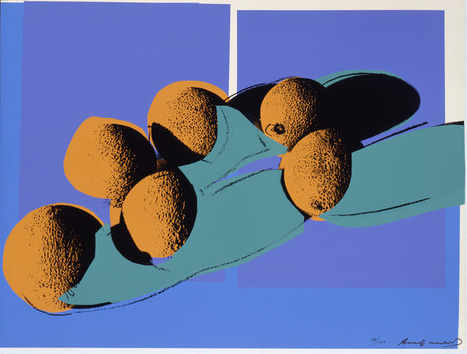The following assessments can be used for this lesson using the downloadable assessment rubric.
- Communication 3
- Creative process 2
- Creative process 6

Andy Warhol, Space Fruit: Still Lifes (Cantaloupes I), 1979
The Andy Warhol Museum, Pittsburgh; Founding Collection, Contribution Dia Center for the Arts
© The Andy Warhol Foundation for the Visual Arts, Inc.
2002.4.19.4
Throughout his career, Warhol worked with assistants and printers to create numerous print portfolios. In 1977 he met printer Rupert Jasen Smith who worked with him to create the series Space Fruit. These prints demonstrate Warhol’s experimentation with a centuries-old genre in painting—the still life. Still lifes by their very nature are choreographed compositions focusing on shape, color, space, and oftentimes symbolism. Warhol was interested in using shadows as a compositional element. He first placed one or more pieces of fruit on a white background, lit the arrangement from an angled position so that shadows were cast onto the white paper, and then photographed these compositions. He also used collage and drawing to create the source imagery for the additional screens used in each print. This artwork is an example of a multilayer or multicolor” silkscreen print since each color represents a different silkscreened layer. This printing process allowed Warhol endless color combinations within each composition.
When I look at things, I always see the space they occupy. I always want the space to reappear, to make a comeback, because it’s lost space when there’s something in it.
When I have to think about it, I know the picture is wrong. And sizing is a form of thinking and coloring is too. My instinct about painting says, ‘If you don’t think about it, it’s right’. As soon as you have to decide and choose, it’s wrong. And the more you decide about, the more wrong it gets. Some people, they paint abstract, so they sit there thinking about it because their thinking makes them feel they’re doing something. But my thinking never makes me feel I’m doing anything.
Andy Warhol, The Philosophy of Andy Warhol (From A to B and Back Again), 1975
Ask students the following questions:
The following assessments can be used for this lesson using the downloadable assessment rubric.